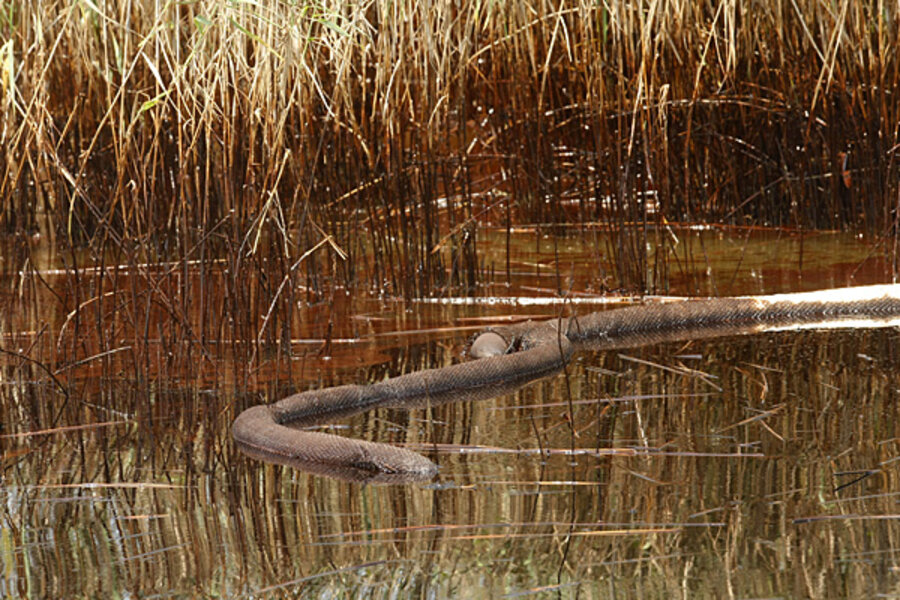BP oil spill: How to save wetlands? Set them on fire, maybe.
Loading...
The most effective tool for cleaning up the oil working its way into southern Louisiana wetlands may, in the end, be the equivalent of a box of kitchen matches.
Controlled burns are perhaps the least-worst alternative among a small handful of approaches to clear contaminated wetlands of oil or its refined products, several researchers say.
So far, oil from the five-week-old BP oil spill has hit about 65 miles of the Louisiana coastline and has traveled as many as 12 miles inland, according to state officials
IN PICTURES: The Gulf oil spill's impact on nature
As oil migrates into the wetlands, several possibilities for dealing with it exist. But not all of them may be practical in this situation, cautions Qianxin Lin, a coastal ecologist at Louisiana State University in Baton Rouge.
Part of the challenge is that the oil reaching the coast has had several days to weather – essentially losing the components that evaporate most readily, leaving a thicker, watery mousse to move inland with winds and tides.
1. Mighty microbes
One approach that could work is to fertilize the microbial community with nitrogen and phosphorous, which boost the population of the microbes and increases their level of activity. The hope is that the beefed-up microbe population in the affected wetlands would degrade the oil.
But because the oil is affecting tidal wetlands "we should be very cautious," says Dr. Lin.
This method is best suited for marsh areas isolated from the rise and fall of tides, he adds. Tides could carry the nutrients out into the Gulf, triggering algae blooms, which already are a problem offshore.
The problem of algae blooms manifests itself each spring and into mid-summer in the Gulf's so-called dead zone. The zone is triggered as nutrients flow down the Mississippi, triggering a population explosion of plankton off the coast. The plankton eventually die and decompose, a process that strips the once-plankton-rich waters of oxygen vital to fish and bottom dwellers such as crab and shrimp.
Moreover, the marsh sediment already is oxygen poor. Even when fertilized, microbes might not become as active as anticipated because microbial activity could be limited by the relative lack of available oxygen.
2. Cutting marsh grasses
Another approach involves cutting the oil-coated marsh grasses at the surface
This method would leave the roots intact to hold the soil and regenerate new grass during subsequent growing seasons but would help get rid of oil that can contaminate animals that wander through the grasses.
The movement of people or machines through an affected marsh, however, could drive any oil that has seeped into the sediment deeper, where it can remain to affect the ecosystem for decades, scientists say.
3. Controlled burn
That leaves burning the oil and oiled grasses as the approach that may stand the best chance of helping the wetlands recover, Lin says.
The approach appears to have been successful in dealing with a relatively small spill triggered by hurricane Katrina, according to Amy Merten, a researcher with the National Oceanic and Atmospheric Administration.
In a report documenting the effort, she writes that the storm destroyed a storage tank owed by Chevron Oil. Most of the oil remained in retention areas designed to contain the leaks. Later, however, hurricane Rita drove roughly 100 to 200 barrels of the oil into an adjacent marsh. Burning the marsh removed between 80 and 90 percent of the oil. Much of the rest was soaked up later with nets or special oil-absorbent material.
Interestingly, the burn took place months after Rita hit, suggesting that, under some conditions, there need not be an extreme sense of urgency if authorities choose this option.
Enough residue remained to be deemed a hazard to wildlife for a time. But after about two years, monitoring efforts showed that the ecological structure and function of the burned marsh returned to closely match those of adjacent, unburned and untainted marshes, Lin says.
The technique isn't a panacea, notes Lin, who along with LSU colleague Irving Mendelssohn, has studied it. If water levels in the marsh are too low – perhaps an inch or less covering the sediment – the fire's heat likely will destroy the roots, which are vital to preventing erosion. And any intrusion of oil into the soil also can kill off the plants.
Soil retention is crucial to a delta region already losing some 34 square miles of coast a year to sea-level rise – a trend being aggravated by ecologically harmful land-use and flood-control practices.
Efforts to deal with the oil encroaching on wetlands represent "a real challenging problem," Lin says.
IN PICTURES: The Gulf oil spill's impact on nature
Related:





